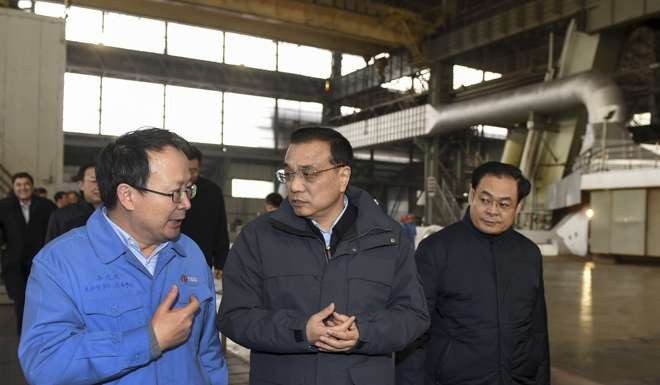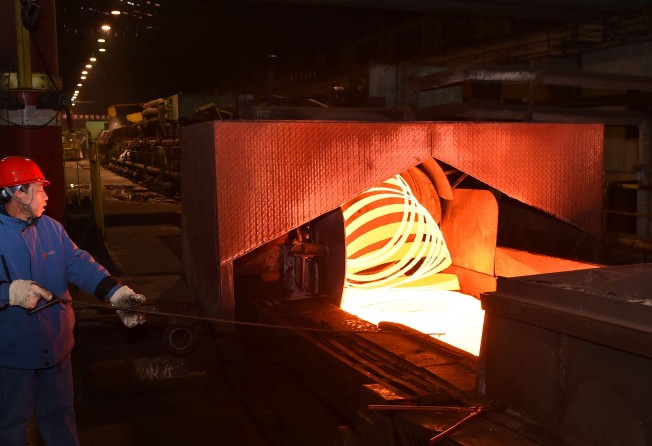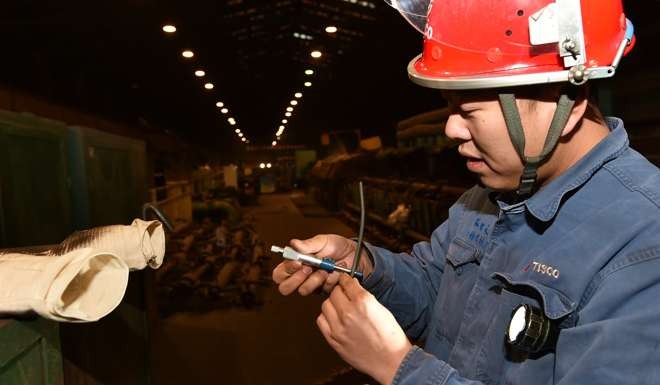
Why cracking the secret of the ball-point pen is such a big deal for Taiyuan Steel
More steel product successes seen possible after ball-point pen ‘breakthrough’

Taiyuan Iron & Steel Group’s recent breakthrough in producing the metal ball casing for ball-point pens could herald more technological advancement by Chinese steel producers to reduce imports for some key products, according to analysts.
The breakthrough has allowed the industry to get around its reliance on foreign suppliers of a key component in one industry, but more needs to be done for Chinese industry to churn out high value-added products amid overcapacity of low-end products.
But to speed up technological breakthroughs, they might have to raise the effectiveness of their research and development spending, while the government could foster greater research spending of smaller firms by improving legal protection for intellectual properties, they said.
Wu Wenzhang, chairman of industry consultancy Shanghai SteelHome, said the Chinese steel industry, the world’s largest, had ample research capacity, including in the technology-intensive aerospace, oil and gas, and car sectors.

“The product development capabilities of China’s steel industry are pretty strong,” he said. “Where the momentum is lacking is that new product investment is primarily made by the large steel mills and not the medium and small ones ... Investment has been held back by concerns that intellectual property would be stolen and that returns may not cover investment.”
State-owned Taiyuan Steel said in a statement in January that after five years of research and development, it had come up with the right materials composition to mass-produce the steel needed to make the “ball socket” that held the freely rotating metal ball at the tip of a ball-point pen, whose movement within the socket allowed the ink to be dispensed.
While the industry has been able to produce the tiny steel balls to meet both domestic and export demand, it had previously not been able to produce the sockets with the quality to match imports.
“Both the steel material and the equipment for making the sockets had to be imported for a long time due to its sophisticated structural precision and extremely high mechanical requirements for processing,” the company said.
Taiyuan Steel, one of the country’s largest stainless-steel makers, said after close to 100 experiments, it had made “major breakthroughs” on seven technical challenges.
They include the steel’s performance stability, corrosion resistance and “free-cutting” property that allows it to be machined easily.
Among other challenges are coming up with the right process for blending different metals in the alloy and harmless treatment of impurities.

Taiyuan Steel said its product was subject to 1,000 tests in a laboratory of a major domestic pen producer, and a pen made of the material was demonstrated to be able to write for 800 metres at different angles without a break.
The secret to the breakthrough lay in the right thinness of the “additives”, including lead and tellurium, mixed into the steel to give it the suitable degree of hardness and enhanced “free-cutting” property, the Shanxi Evening News quoted Wang Huijin, senior engineer of the company’s technology centre, as saying.
Tellurium is one of the rarest stable solid elements in the Earth’s crust.
As part of a state-supported project that forms part of Beijing’s five-year technology development plan to 2015, the firm had joined hands with pen maker Ningbo-based Beifa Group in the experiments.
Taiyuan Steel has also come up with China’s first technical standards for the pen-used steel part that has been endorsed by an industry expert committee.
Mass domestic production of the steel wire used to make the sockets, of 2.3 millimetres in diameter, is expected to be able to replace imports in two years, according to Taiyuan Steel.
This means producers in Japan and Switzerland will be losing sales to China and face competition from Chinese producers in the future.
According to a Xinhua report in January, China imports more than 1,000 tonnes of special steel used to make ball-point pen nib sockets at about 120,000 yuan per tonne, costing more than 120 million yuan annually.
About 90 per cent of the socket-used steel and 80 per cent of ink used in ball-point pens made in China was either imported or made with foreign-made machines, while Chinese pen makers only made a profit of 10 US cents for each pen sold for US$1.99 in the United States, Minister of Science and Technology Wan Gang was quoted byXinhuaas saying in 2011.
In that year, the ministry launched a 60 million yuan support scheme to spur domestic industrialisation of key pen-manufacturing materials and equipment.
The pen industry’s reliance on foreign precision parts has long been a source of embarrassment to China, which is known for its manufacturing prowess. Premier Li Keqiang a year ago highlighted the need for focused investment and research efforts in the sector to help bolster higher-value manufacturing.
China’s steel industry, which has been criticised for flooding the international market with lower-end products that attracted anti-dumping duties, exported 108.4 million tonnes in 2016, reflecting a 3.5 per cent decline from 2015, according to Customs data.
Less well-known is its steel products imports, which amounted to 13.2 million tonnes in 2016, up 3.4 per cent from 2015 but tiny compared to its consumption of almost 700 million tonnes.
Wu said many of the products imported were used in parts for producing vehicles, electrical appliances and nuclear power plants. These applications require a high level of sturdiness and in certain cases resistance to temperature, pressure and radiation.
He noted that research and development spending by some of China’s largest steel mills had compared favourably to those of their global rivals on a proportion to sales basis.
Baoshan Iron & Steel, China’s most profitable steel producer, has spent between 3.4 billion yuan and five billion yuan on research and development between 2011 and 2015, or 1.8 to 2.3 per cent of its annual sales, according to its annual report.
It had 1,105 research staff, accounting for 2.9 per cent of its total staff.
Rival Angang Steel spent 2.4 to 2.8 per cent of its sales on research in the five years and had 1,898 research staff, accounting for 5 per cent of its total at the end of 2015.
By comparison, Luxembourg-based ArcelorMittal, the world’s largest steel producer, spent between US$227 million and US$270 million, or about 0.3 per cent of its sales on research, between 2013 and 2015.
Japan’s Nippon Steel and Sumitomo Metal spent about US$592 million on research in the latest financial year, or 1.6 per cent of total sales.
Taiyuan Steel appeared to have put a special emphasis on research, with its listed unit Shanxi Taigang Stainless Steel spending 2.1 to 2.6 per cent of its sales on research between 2012 and 2015. Its 2,501-strong team amounted to 13.4 per cent of its total payroll.
Li Hongmei, senior editor for metals and steel at information provider S&P Global Platts, said besides cars, another sector where imports still played a role in China’s steel market was offshore engineering, where oil and gas drilling platforms needed to be made of steel that could withstand high pressure with strong anti-corrosion properties for three to five decades.
“Chinese steel mills have long been impressive when it comes to production volume growth, but they have yet to reach an advanced level when it comes to quality achievements compared to more advanced steel-producing regions,” she said.
“It will still be a challenging journey for Chinese mills to catch up ... given that foreign firms are understandably guarding their know-how, but with China’s excess steel capacity, the domestic steel mills have realised the pressing need for them to evolve in order to survive sustainably.”

